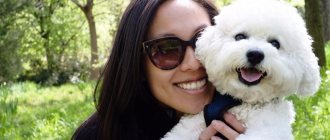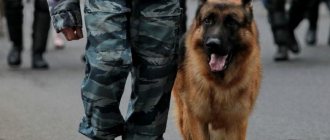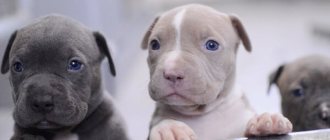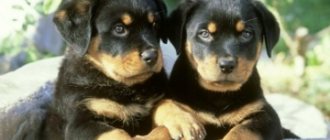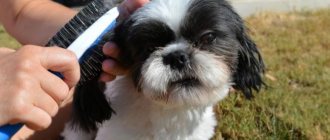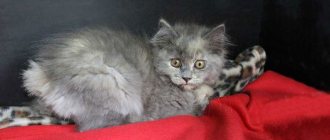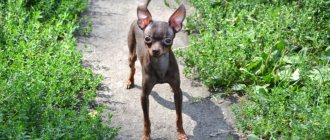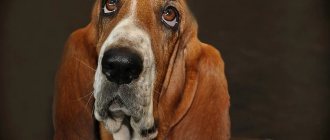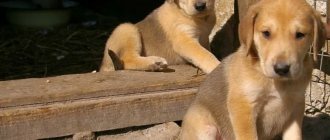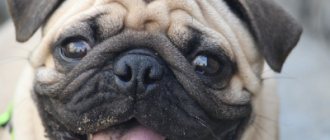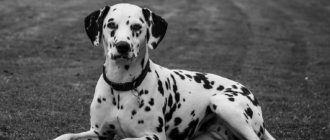The Brussels Griffon is a small, cheerful dog with a funny expression on its face. Despite her extravagant appearance due to her upturned nose and unkempt beard, she has aristocratic manners. This smart, cheerful and active dog can become a favorite of the whole family, a devoted companion. Previously, griffons were used as watchmen and rat catchers. Now the breed is classified as decorative. Before you get this dog, you need to learn everything about the Brussels Griffon breed. Reviews from owners and videos will help you get acquainted with the pros and cons of the content and learn about character traits.
- How do Belgian, Brussels and Brabant Griffons differ from each other?
- Head
- Education and training
- Grooming
Breed traits
Breed traits (on a 5-point scale)
| Brussels Griffon | |||
| Activity | in the house | 3 | |
| on the street | 3 | ||
| Obedience | training | 3.5 | |
| strangers | 4 | ||
| Domination | in family | 2 | |
| over dogs | 2 | ||
| Defending your territory | from people | 1.8 | |
| from dogs | 2 | ||
| Sociability | in family | 5 | |
| with strangers | 4.5 | ||
| with dogs | 3 | ||
| Concentration | in family | 1 | |
| in front of strangers | 2 | ||
| with dogs | 2 | ||
| Aggressiveness | in family | 1 | |
| to strangers | 1.5 | ||
| to the dogs | 2 | ||
| to cats | 2 | ||
| Family behavior | calmness | 4 | |
| demand for affection | 4 | ||
| excitability | 4 | ||
| playfulness | 3.6 | ||
| excessive barking | 2.7 | ||
| behavioral breakdowns | 1.5 | ||
| Tolerance for children | up to 4 years | 4 | |
| over 4 years old | 3.8 | ||
| Institutional use | watchman | 1 | |
| bodyguard | 1 | ||
This breed is often compared to the following dog breeds: Affenpinscher, Yorkshire Terrier, French Bulldog, Chihuahua, Pug.
The photo shows what Brussels Griffons look like:
Brussels Griffons: general characteristics of the breed
Brussels Griffons are one of the small, short-haired Belgian dogs. They can be recognized by their unusual monkey-like face with protruding mustache and goatee. These dogs were previously kept on farms to catch rats, but are now kept as companions. They are cheerful, smart, active and sociable. They choose one owner and are ready to follow him everywhere.
Thanks to its cheerful character and funny appearance, you won’t get bored with such a pet. Despite their small size, Brussels Griffons can perform watchdog or security duties. They are distrustful of strangers and have a sensitive sense of smell and hearing. They always warn of the approach of strangers, and if necessary, they boldly rush to the defense of their owner.
| Options | Characteristic |
| breed name | Brussels Griffon |
| a country | Belgium |
| group of breeds according to the ICF classification | companion dogs and toy dogs, small Belgian dogs section |
| application | rat catcher, watchman, companion |
| life expectancy | 12-15 years |
| height | 18-20 cm |
| weight | 3-6 kg |
| activity | average |
| aggressiveness | average |
| intelligence | tall, but difficult to train |
| difficulty of care | easy, moderate shedding |
pros
Brussels Griffons are a decorative breed. Due to their small size, they can be kept in a city apartment. They are not prone to aggressive behavior and get along well with school-age children. These dogs have several more advantages:
- unusual funny appearance;
- loyal, attached to the owner;
- cheerful, active;
- balanced character;
- smart, inquisitive;
- love to learn, are good at learning different tricks;
- brave, have innate guard qualities;
- get along well with other pets;
- do not require long walks and high physical activity;
- the coat hardly sheds and does not cause allergies;
- They have good immunity and a long life expectancy.
Minuses
This breed is quite rare in our country, although it is popular in its homeland. It is not recommended for inexperienced dog breeders and people with a mild character to get one. Despite its high intelligence, the griffin is difficult to train. This dog has a few more disadvantages that may create problems for some owners:
- cannot stand loneliness, they need to constantly be near their owner;
- do not get along well with small children (under 5 years old);
- jealous, may be jealous of the owner towards other family members;
- love to play pranks;
- bark loudly, snore in their sleep;
- predisposed to complications during childbirth and other diseases;
- special coat care, trimming required.
The video complements the characteristics of the Brussels Griffons:
Video: All about the Brussels Griffon breed
Video: Brussels Griffon. Breed characteristics, care
Training
Dogs of the Griffon breed achieve excellent results in competitions and sports. It should be remembered that at first the dwarf griffin was instilled with hunting instincts, so training will not be easy.
First you need to gain the baby's trust in the owner. Repeat the exercises several times, achieving obedience.
For a small dog, training will be more likely during play. Rewarding with small pieces of goodies will consolidate the result. Miniature griffins will become your faithful companions, not letting you get bored. Just don’t pamper them too much; smart dogs will take advantage of this.
History of the origin of the Brussels Griffon breed
Dogs similar to the modern Brussels Griffon were known back in the 15th century. You can find their images in paintings by artists of that time. These small shaggy dogs were mainly popular among farmers and were called "smoothie". They protected grain barns from rodents. A sensitive sense of smell, courage and the ability to penetrate hard-to-reach places made them good rat catchers.
In the 19th century, representatives of the nobility drew attention to funny dogs. It became popular among noble ladies to keep griffons. They protected carriages, carriages, and stables from rats. Then they began to accompany their owners to balls and receptions. Queen Maria Henrietta, Draga of Serbia and others had such dogs. Unlike other decorative dogs, they were valued not for their appearance, but for their loyal character and friendly behavior.
At the end of the 19th century, fanciers created a breed club, held exhibitions, and began keeping a stud book. At that time the breed was called the Small Wirehaired Belgian Terrier. Several breed lines were identified, the differences between which were in the length and color of the coat, and size. They began to be called griffins. This word is translated from French as “wire-haired.”
At the beginning of the 20th century, a breed standard was developed, and dogs began to be exported outside the country. They gained popularity in America, Great Britain, and France. After World War II, the number of representatives of the breed was greatly reduced. Until now, it remains small and rare, almost unknown in Russia.
How do Belgian, Brussels and Brabant Griffons differ from each other?
There are three varieties of griffons, which differ little:
- Belgian ones come from Affenpinschers, they are short-haired, black in color;
- Brussels came from crossing Affenpinschers with Cavalier King Charles Spaniels, this affected the color of the coat;
- Brabant or Petit-Brabantson - pugs were involved in breeding, so they are smooth-haired and smaller in size.
The differences between the lines are only in the type of coat and color, so they often cross with each other. Now all three breeds are united under the name “small Belgian dogs”. Their peculiarity is that representatives of all three lines can be born in one litter. Differences appear as they grow older.
The smooth-haired and smallest in size are classified as Brabantsons. The rest differ in color, which develops after 4-5 months. Belgians have a darker color; Brussels can be tan or chocolate brown.
Photos of three varieties of the breed:
The video will help you learn to distinguish between griffons of different lines:
Video: 4 differences between the Brussels, Belgian Griffon and Petit Brabançon
Common diseases
There are no diseases specific to this breed. Ornamental griffons are susceptible to the same pathologies as other miniature pets and brachycephalics: dislocation of the kneecap, hip dysplasia, breathing problems, etc. The main “enemies” of the breed are eye diseases and difficult childbirth.
Griffons have bulging eyes, so they can be easily injured. Very often, irritation occurs due to long hair getting on the mucous membrane or improper eyelash growth. Interfering hairs need to be trimmed regularly. For other problems, you should contact your veterinarian.
Check your griffon regularly to make sure there is no fur in its eyes.
The Griffon is not a dog that can be safely left alone during childbirth. In 90% of cases, the pet fails to give birth to puppies on its own. It is highly recommended that you have your veterinarian come to your home so that he can perform a caesarean section if complications occur.
Griffons have a high mortality rate at an early age. This happens due to strict natural rejection: dogs suffer most diseases in childhood. For breeders this is a huge minus, but for buyers it is a significant plus. The likelihood of purchasing a healthy puppy increases.
Appearance Standards
Brussels Griffons are a decorative breed. But unlike other similar dogs, they cannot boast of a beautiful appearance. This is a stocky, slightly rough dog with a shaggy muzzle, on which a mustache and goatee stick out and large eyes stand out. The average size of a dog is 27-30 cm, males grow up to 32 cm. Weight can be up to 6 kg. Bitches are smaller and more graceful.
Head
The head is round, looks large in relation to the body, the forehead is convex. The brow ridges are not pronounced, the stop is sharp and deep. The muzzle is short, up to 2 cm long, upturned. When viewed in profile, the tip of the nose is in line with the forehead. The chin protrudes slightly forward. The lower jaw is U-shaped, raised, the bite is undershot. The lips fit tightly, the teeth and tongue are not visible. Nose with wide nostrils, black.
The ears are small, widely spaced, and set high. They are triangular in shape, semi-erect, turned forward. The eyes are round, large, and wide-set. Should not be convex. The eyelids fit tightly, hide the whites, and are covered with long eyelashes. The color is dark brown. The look is expressive, intelligent, human.
Frame
The body is stocky and square in format. The neck is of medium length, muscular, withers are moderately expressed. The chest protrudes forward, is deep, the ribs are rounded, the belly is tucked. The back is straight and short. The loin is slightly raised, the croup is sloping. The tail is set high. Usually it is raised, the tip is curved, but does not touch the back and does not curl.
Limbs
The limbs are muscular, with strong bones. The front ones are parallel, set wide apart, elbows tucked in. The hindquarters are set back slightly and the hocks are low. The paws are rounded, the toes are collected in a ball, the claws are black. There should be no dewclaws. Movements are free. The dog pushes off powerfully and runs at a trot.
Coat and color
This is a short-haired dog. The guard hair is hard, wiry, slightly wavy. The undercoat is dense and short. Doesn't shed on its own, needs trimming. Longer hair on the face: forms a beard, mustache, sideburns and eyebrows.
The color of the Brussels Griffon can be brown, red, chocolate, beige, fawn. A darker mask often stands out on the muzzle. The modern standard also allows black color. There should be no white spots.
Photos complement the description of the appearance:
Character of Brussels Griffons
The Brussels Griffon looks tough at first glance. But in fact, this is a funny, cheerful and sociable dog. She loves to be the center of attention, is ready to follow her owner everywhere and participate in all his affairs, and can even be obsessive. These dogs can be described as follows:
- affectionate;
- good-natured;
- cheerful;
- devotees;
- reserved;
- sensitive;
- touchy;
- jealous;
- stubborn;
- brave.
Griffon chooses one master for himself and remains faithful to him. Treats other family members kindly. It gets very bored when apart and cannot stand loneliness, so you should not get this breed for those who are often not at home. This dog happily accompanies its owner on hikes and nature trips. He loves walks, although he does not need long-term physical activity.
Griffons are wary of strangers and do not allow themselves to be petted. They have innate watchdog qualities, are vigilant, have good hearing and sense of smell. With a ringing bark they warn the owner of the approach of strangers. Despite their small size, they boldly rush to defense if necessary.
This dog can become the best friend and devoted companion for an elderly person or teenager. He loves to frolic with school-age children and can become a play partner. But he does not like rude treatment and will not tolerate the pranks of children. Therefore, families with small children are better off not getting this breed.
Griffons are patient with other pets. They are friends with dogs and cats if they have lived with them since childhood. But sometimes they can be jealous and protect their place and toys.
Education and training
The Brussels Griffon is an intelligent, inquisitive dog. He quickly understands what is required of him, but this does not mean that he is easy to train. First you need to gain authority - these dogs tend to dominate, can be stubborn and wayward.
You need to start raising and socializing a griffin as early as possible. It is important from the first days of the puppy’s arrival in the new home to show him who is in charge, to accustom him to the place, daily routine, and toilet. He must come to me on command and know his nickname. On the street, you need to teach him to walk on a leash, to react calmly to the noise of cars, to strangers.
These dogs are inquisitive, smart, and usually remember basic commands quickly. This is “place”, “impossible”, “sit”, “near”, “stand”. For more serious training, you can seek help from a dog trainer. Griffons show good results in agility, freestyle, and obedience. The peculiarity of representatives of this breed is that they can climb trees.
When raising a griffin on your own, you should use the recommendations of experts:
- training must be consistent, basic requirements must be followed by all family members;
- classes are regular, short, so that the puppy does not get tired;
- You must be patient, you must not raise your voice or use rudeness;
- use encouragement more often: affection, praise, treats.
Photos of Brussels Griffons complement the description of the behavior of the breed:
Features of maintenance and care
The Brussels Griffon is a family pet. It cannot be kept in a booth or enclosure outside. Due to its small size, it is suitable for small apartments. This dog can even be taught to go to the toilet in a diaper. Although an adult dog needs 2-3 walks a day for at least half an hour. When walking with your pet, you need to play and run. Just long monotonous walking or running is not recommended.
Griffons love secluded places, so it is better for him to buy a closed house. There he can hide his toys and treats. These dogs often carry small objects to their place: pens, pencils, slippers, wires. For this habit, griffon owners call them brownies. The place needs to be arranged away from heating devices, as these dogs do not tolerate heat well.
Grooming
The Brussels Griffon is unpretentious. But he requires special care - grooming. These are hygiene procedures: caring for fur, eyes, ears, claws. If your dog is being shown, it is better to visit a salon for professional grooming. For your pet, you can perform these procedures yourself.
- Griffons require trimming - plucking of hairs. It is carried out once every 2-3 months. Using this procedure, dead hairs are removed, since the griffin's fur does not shed on its own.
- Every week you should comb the body fur with a fine-tooth comb. You will also need a furminator and a special rubber glove. It is recommended to comb the beard, mustache and eyebrows daily, and wipe them after eating so that no pieces of food remain in the fur.
- A hygienic haircut is required. You need to remove hair from the ears, under the tail, between the toes. It is important to trim your eyebrows, as coarse hairs irritate your eyes. Trimming the hair on the body and face is not recommended - it makes it softer and affects the color. Because of this, breed characteristics are lost.
- The griffin needs to be bathed once every 3-4 months. Use shampoo for wire-haired dogs. After walks, wash your paws; in dirty weather, it is better to take your pet outside in waterproof overalls.
- Every week, inspect your ears, remove dirt and wax with a cotton pad soaked in a special product. Wipe your eyes as needed with boiled water or tea leaves.
- Griffons are prone to dental diseases. It is recommended to brush your teeth with a special paste several times a week. It is also useful to give your pet chewing bones.
- If a dog doesn't walk on the pavement a lot, its nails won't wear down. Therefore, they need to be cut 1-2 times a month with a nail clipper.
Nutrition
The Brussels Griffon is prone to allergies, so you need to choose his food carefully. You can feed them natural food or dry food, just don’t mix them. To prevent your dog from gaining weight, you need to control the amount of food. There should always be clean water in a separate bowl.
Ready-made food is convenient because it is easier to dose, there is no need to waste time on preparation and you do not need to give your pet vitamin supplements. You just need to choose super-premium or holistic class options. The food should be intended for active small breed dogs.
When feeding naturally, the bulk of the diet should be lean meat. Several times a week it can be replaced with offal and sea fish. This food is mixed with porridge and vegetables. It is useful to give your dog fermented milk products, herbs, apples, and vegetable oil.
Food from the human table, fried, fatty, salty foods, smoked meats and canned food is prohibited. You should not give your pet sweets, confectionery, baked goods, legumes, or tubular bones.
Health
The health of griffins is quite good, with an average life expectancy of 12-14 years. With good care, the dog lives longer than 15 years. But due to the peculiarities of their physiology, they have congenital and acquired diseases:
- retinal atrophy;
- cataract;
- eye loss;
- narrowed nostrils;
- stenosis of the nasal cavity;
- joint dysplasia;
- dislocated kneecaps;
- allergic reactions;
- hydrocephalus;
- Perthes syndrome.
In order for your pet to live longer and stay healthy, you need to visit the veterinarian regularly. It is important to get all the age-appropriate vaccinations and anthelmintic treatment. When purchasing a dog of this breed, you need to take into account that bitches often have complications during childbirth, and many puppies die.
Common diseases
Despite their strong build and endless energy, small Belgian dogs suffer from many diseases, including hereditary ones. The most common ones are:
- distichiasis (growth of eyelashes near the eyeball, constantly leading to injury);
- prolapse of the eyeball;
- narrowing of the nasal passages;
- retinal atrophy (progressive);
- cataract;
- hydrocephalus of the brain.
Female griffons have a very difficult time with the birth process due to the narrow birth canal, so birth in these small dogs takes place only in the presence of a veterinarian and usually ends with a cesarean section.
Little “Belgians” are susceptible to various viral infections, so it is very important to vaccinate animals in a timely manner. Under good conditions, dogs live for at least 13-15 years, but there are cases where griffons have delighted their owners for 20 years or more.
How to buy a Brussels Griffon puppy
This breed is quite rare in our country, but you can buy a purebred puppy in a nursery. The price of a griffon in Moscow starts from 40 thousand rubles. These are pedigree dogs tested for genetic diseases. The cost of puppies without documents is less - 15-20 thousand rubles. The low price should alert the future owner: perhaps the dog is not purebred or healthy.
When choosing a puppy, it is recommended to first study the living conditions of the animals and get to know the mother. Then observe the behavior of the dogs. You need to choose an active baby who does not show cowardice or aggression. At the age of 2-3 months, when puppies are sold, breed characteristics are already visible. You need to pay attention to the format of the body, the structure of the muzzle, and the condition of the coat.
The photo shows what the puppies look like:
The video will complement the description of the breed:
Video: Brussels Griffon all about the breed. Interesting Facts
Video: Brussels Griffon
Brussels Griffons are funny and intelligent dogs. They are unusual not only in appearance, but also in character. It is better not to get this breed for beginners or people with a soft character; it is also not suitable for families with small children. But if you raise this dog correctly and give him enough attention, he will become your best friend, with whom you will never be bored.
Walk
The Griffon, like other small dogs, does not need much physical activity.
- This is very convenient for older breeders or for those who, due to their busy schedule, cannot walk their pet every day.
- If you train a dog to use a litter box, it can do without walking, but in this case you should definitely play outdoor games with the animal in the apartment to prevent obesity.
- Griffons that are walked daily look better, grow and develop faster, and have a higher intellectual level.
- The duration of the walk should not exceed an hour to an hour and a half. Active physical activity (running, jumping) should be avoided, as the animal gets tired quickly.
You should also not walk in crowded areas or take your dog on public transport, as griffins are very shy. It is better to walk in a specially designated area. If your dog becomes stubborn during a walk, you need to carefully switch its attention to something new. The dog is easily distracted and obeys the owner's orders.
